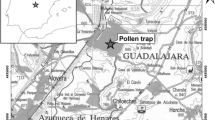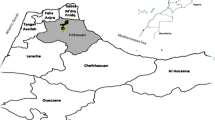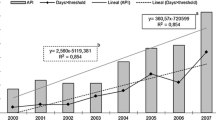Abstract
Airborne pollen calendars are useful to estimate the flowering season of the different plants as well as to indicate the allergenic potential present in the atmosphere at a given time. In this study, it is presented a 10-year survey of the atmospheric concentration of allergenic pollen types. Airborne pollen was performed, from 2003 to 2012, using a 7-day Hirst-type volumetric trap. The interannual variation of the daily mean concentration of the number of pollen grains and the main pollen season was determined as well as the hourly variations and correlation with meteorological parameters. During the study period, 18 different allergenic pollen types were considered based on its representativeness on the total annual airborne pollen concentration. The lowest annual concentrations were sampled in 2006 and the highest in 2007. The highest airborne pollen concentration was found during early spring and early summer. On the contrary, December was the month with the lowest pollen concentration. The major pollen sampled belongs to trees followed by weeds and grasses, being the most representative pollen types in the atmosphere: Urticaceae, Platanus, Poaceae, Pinaceae, Cupressaceae, Acer, Quercus, Castanea, Plantago, Alnus, Olea europaea, Betula, Myrtaceae and Populus. Intradiurnal distribution patterns of the pollen types studied presented differences with some taxa being predominantly sampled in the morning (9–11 a.m.) while others in first night hours (between 9 and 12 p.m.). Significantly correlations were found between the airborne pollen concentration and meteorological parameters.




Similar content being viewed by others
References
Abreu, I., & Ribeiro, H. (2005). Allergenic pollen in the city of Porto (Portugal). Allergy, 60, 1452–1453.
Aira, M. J., Rodríguez-Rajo, F. J., Fernández-González, M., & Jato, V. (2011). Airborne pollen of ornamental tree species in the NW of Spain. Environmental Monitoring and Assessment, 173(1–4), 765–775.
Boi, M., & Llorens, L. (2013). Annual pollen spectrum in the air of Palma de Mallorca (Balearic Islands, Spain). Aerobiologia, 29(3), 385–397.
Caeiro, E., Brandão, R., Carmo, S., Lopes, L., Morais de Almeida, M., Gaspar, A., et al. (2007). The Portuguese aerobiology network: Airborne pollen results (2002–2006). Revista Portuguesa de Imunoalergologia, 15(3), 235–250.
Caeiro, E., Lopes, L., Gaspar, Â., Todo-Bom, A., de Oliveira, J. F., Nunes, C., et al. (2013). The diurnal variation study of grass pollen concentrations in atmosphere of mainland Portugal. Revista Portuguesa de Imunoalergologia, 21(1), 27–40.
Câmara, I. (2008). Estudo aerobiológico da cidade do Funchal. Detecção bioquímica dos principais aeroalergénios. Ph.D. thesis, University of Madeira, Funchal, Portugal.
Cariñanos, P., & Casares-Porcel, M. (2011). Urban green zones and related pollen allergy: A review. Some guidelines for designing spaces with low allergy impact. Landscape and Urban Planning, 101(3), 205–214.
Dahl, Å., Galán, C., Hajkova, L., Pauling, A., Sikoparija, B., Smith, M., et al. (2013). The onset, course and intensity of the pollen season. In M. Sofiev & K.-C. Bergmann (Eds.), Allergenic pollen (pp. 29–70). Netherlands: Springer.
D’Amato, G., Cecchi, L., Bonini, S., Nunes, C., Annesi-Maesano, I., Behrendt, H., et al. (2007). Allergenic pollen and pollen allergy in Europe. Allergy, 62(9), 976–990.
Duque, L., Guimaraes, F., Ribeiro, H., Sousa, R., & Abreu, I. (2013). Elemental characterization of the airborne pollen surface using Electron Probe Microanalysis (EPMA). Atmospheric Environment, 75, 296–302.
Fernandes, F. M., Molina, R. T., & de Carvalho, L. M. M. (2010). Aeropalynological assessment of Beja (South Portugal). Revista Portuguesa de Imunoalergologia, 18(5), 419–429.
Fernández-Rodríguez, S., Skjøth, C. A., Tormo-Molina, R., Brandao, R., Caeiro, E., Silva-Palacios, I., et al. (2013). Identification of potential sources of airborne Olea pollen in the Southwest Iberian Peninsula. International Journal of Biometeorology,. doi:10.1007/s00484-012-0629-4.
Galán, C., Tormo, R., Cuevas, J., Infante, F., & Domínguez, E. (1991). Theoretical daily variation patterns of airborne pollen in the South-West of Spain. Grana, 30(1), 201–209.
Hernandez-Ceballos, M. A., Soares, J., García-Mozo, H., Sofiev, M., Bolivar, J. P., & Galán, C. (2013). Analysis of atmospheric dispersion of olive pollen in southern Spain using SILAM and HYSPLIT models. Aerobiologia,. doi:10.1007/s10453-013-9324-0.
Linskens, H. F., & Cresti, M. (2000). Pollen-allergy as an ecological phenomenon: A review. Plant Biosystems, 134(3), 341–352.
Miranda, P., Coelho, F. E. S., Tomé, A. R., & Valente, M. A. (2001). 20th century Portuguese climate and climate scenarios. In F. D. Santos, K. Forbes, & R. Moita (Eds.), Climate change in Portugal. Scenarios, impacts and adaptation measures—SIAM. Executive summary and conclusions (1st ed., pp. 23–84). Lisbon: Gradiva.
Moreno-Grau, S., Bayo, J., Elvira-Rendueles, B., Angosto, J. M., Moreno, J. M., & Moreno-Clavel, J. (1998). Statistical evaluation of three years of pollen sampling in Cartagena, Spain. Grana, 37(1), 41–47.
Nunes, C., Câmara, I., Ferreira, M. B., Morais de Almeida, M., Gaspar, Â., Loureiro, C., et al. (2008). Airborne fungal spores in Portugal. Revista Portuguesa de Imunoalergologia, 16(4), 377–394.
Pacini, E., & Hesse, M. (2004). Cytophysiology of pollen presentation and dispersal. Flora, 199(4), 273–285.
Peden, D., & Reed, C. E. (2010). Environmental and occupational allergies. Journal of Allergy and Clinical Immunology, 125(2), S150–S160.
Pérez-Badia, R., Rapp, A., Vaquero, C., & Fernandez-Gonzalez, F. (2011). Aerobiological study in east-central Iberian Peninsula: Pollen diversity and dynamics for major taxa. Annals of Agricultural and Environmental Medicine, 18(1), 99–111.
Pinto da Silva, Q. (1955). Le contenu pollinique d’air à Lisbonne. Agronomia Lusitana, 17, 5–16.
Pinto da Silva, Q. (1960). The incidence of Olea pollen in Portugal in five consecutive years. Acta Allergologica, 15, 107–112.
Pinto da Silva, Q. (1964). Análise polínica do ar do Porto. O Médico, 665, 3–24.
Ribeiro, H., Cunha, M., & Abreu, I. (2003). Airborne pollen concentration in the regions of Braga, Portugal, and its relationship wit meteorological parameters. Aerobiologia, 19, 21–27.
Ribeiro, H., Cunha, M., & Abreu, I. (2005). Airborne pollen of Olea in five regions of Portugal. Annals of Agricultural and Environmental Medicine, 12(2), 317–320.
Ribeiro, H., Cunha, M., & Abreu, I. (2007). Definition of the main pollen season using a logistic model. Annals of Agricultural and Environmental Medicine, 14, 159–167.
Ribeiro, H., Oliveira, M., & Abreu, I. (2008). Intradiurnal variation of allergenic pollen in the city of Porto (Portugal). Aerobiologia, 24(3), 173–177.
Ribeiro, H., Oliveira, M., Ribeiro, N., Cruz, A., Ferreira, A., Machado, H., et al. (2009). Pollen allergenic potential nature of some trees species: A multidisciplinary approach using aerobiological, immunochemical and hospital admissions data. Environmental Research, 109(3), 328–333.
Ring, J. (2012). Davos declaration: Allergy as a global problem. Allergy, 67(2), 141–143.
Scheifinger, H., Belmonte, J., Buters, J., Celenk, S., Damialis, A., Dechamp, C., et al. (2013). Monitoring, modelling and forecasting of the pollen season. In M. Sofiev & K.-C. Bergmann (Eds.), Allergenic pollen (pp. 71–126). Netherlands: Springer.
Sousa, R., Cruz, A., Ribeiro, H., & Abreu, I. (2011). Impact of urbanization level on Chenopodium album pollen: Morphological and immunochemical data. Revista Portuguesa de Imunoalergologia, 19(1), 33–41.
Acknowledgments
This work was funded by FEDER, COMPETE Program, PTDC/AAC-AMB/102796/2008, from FCT, Portugal. The first author benefits from a scholarship (SFRH/BDP/43604/2008) financed by QREN-POPH and FCT.
Author information
Authors and Affiliations
Corresponding author
Rights and permissions
About this article
Cite this article
Ribeiro, H., Abreu, I. A 10-year survey of allergenic airborne pollen in the city of Porto (Portugal). Aerobiologia 30, 333–344 (2014). https://doi.org/10.1007/s10453-014-9331-9
Received:
Accepted:
Published:
Issue Date:
DOI: https://doi.org/10.1007/s10453-014-9331-9




